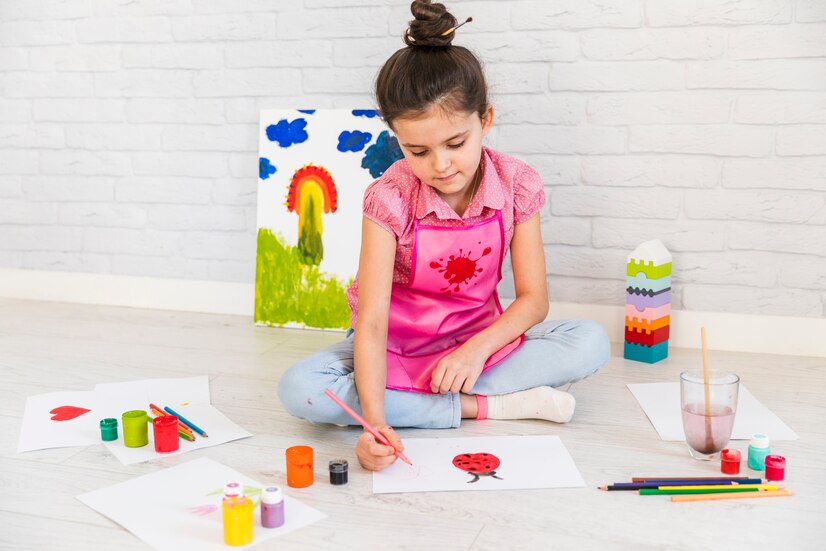Childhood is a time of wonder, exploration, and creativity. One of the most engaging and beneficial activities for children is painting.
It is not only a fun way for them to express themselves but also a crucial tool for their development.
This ultimate guide to kids paint kits aims to help parents and caregivers unleash their child’s inner artist, providing a comprehensive overview of what to look for in a paint kit, the benefits of painting, and tips for nurturing creativity in children.
Understanding the Importance of Art in Child Development
Before diving into the specifics of paint kits, it’s essential to understand why art, and particularly painting, is so vital for children.
Cognitive Development: Engaging in painting helps children develop their problem-solving skills and enhances their understanding of cause and effect.
Mixing colors and creating new shades, for example, teaches them about chemical reactions and color theory in a hands-on way.
Emotional Expression: Painting provides an outlet for children to express their emotions and thoughts in a non-verbal manner. This is particularly beneficial for children who may have difficulty articulating their feelings.
Fine Motor Skills: Handling brushes, palettes, and other painting tools helps refine children’s fine motor skills, improving their hand-eye coordination and dexterity.
Imagination and Creativity: Painting encourages children to use their imagination and think creatively. This fosters innovative thinking, which is crucial in many areas of life and education.
Confidence Building: Completing a painting project gives children a sense of accomplishment and boosts their self-esteem. Displaying their artwork at home or in a classroom can further reinforce this sense of pride.
Types of Kids’ Paint Kits
There is a wide variety of paint kits available for children, catering to different age groups, interests, and skill levels. Here’s a detailed look at some of the most popular types:
Watercolor Paint Kits: Ideal for younger children, watercolor paints are easy to use and clean up. They allow for a range of techniques, from simple washes to more detailed work. Watercolor kits typically include a set of paints, brushes, and a palette.
Acrylic Paint Kits: These are perfect for older children who want to experiment with more vibrant colors and textures. Acrylic paints are versatile and can be used on various surfaces, including canvas, wood, and paper. Kits usually come with a selection of acrylic paints, brushes, and sometimes canvases.
Tempera Paint Kits: Known for their bright colors and quick drying time, tempera paints are great for younger artists. These paints are water-based, making them safe and easy to clean. Kits often include tempera paints, brushes, and painting sheets.
Oil Paint Kits: Although less common for children due to their complexity and longer drying time, oil paints can be introduced to older kids who show a keen interest in painting. These kits come with oil paints, brushes, and canvases, and often include mediums and solvents.
Finger Paint Kit :Perfect for toddlers and preschoolers, finger paint kits allow children to use their hands directly in the creative process. These kits come with non-toxic, washable paints that are safe for little hands.
Specialty Paint Kits: These include kits designed for specific projects, such as rock painting, fabric painting, or ceramic painting. They come with all the necessary materials and instructions, making them great for focused activities.
Choosing the Right Paint Kit
Selecting the appropriate paint kit for your child involves considering several factors to ensure it meets their needs and interests. Here are some key points to keep in mind:
Age Appropriateness: Ensure the kit is suitable for your child’s age. Younger children benefit from kits with non-toxic, washable paints and larger tools that are easier to handle. Older children may enjoy more complex kits with a broader range of materials and techniques.
Safety: Check for non-toxic labels and ensure all materials are safe for children. This is especially important for younger kids who might put things in their mouths.
Interests and Preferences: Consider your child’s interests. If they love animals, look for kits with animal-themed projects. If they enjoy specific styles, like abstract art, find kits that cater to those preferences.
Skill Level: Match the complexity of the kit with your child’s skill level. Beginners might need simpler kits with step-by-step instructions, while more experienced young artists might enjoy kits that allow for greater creative freedom.
Quality of Materials: Higher-quality paints and brushes can significantly enhance the painting experience and the final outcome. Look for kits from reputable brands known for their durability and quality.
Budget: Paint kits come in a wide range of prices. Determine your budget beforehand and look for kits that offer the best value for money, considering the quantity and quality of the materials provided.
Conclusion
Unleashing your child’s inner artist is a journey that involves providing the right tools, environment, and encouragement.
Kids’ paint kits are an excellent starting point, offering a structured yet flexible way for children to explore their creativity. By understanding the benefits of painting, choosing the right kit, setting up a conducive space, and fostering a supportive environment, you can help your child develop not only as an artist but also as a confident and imaginative individual.
Remember, the goal is to enjoy the process and celebrate the joy and expression that comes with each brushstroke.



